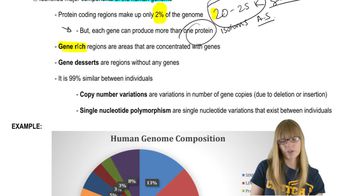Define the process of transcription. Where does this process fit into the central dogma of molecular biology (DNA makes RNA makes protein)?
Table of contents
- 1. Introduction to Genetics51m
- 2. Mendel's Laws of Inheritance3h 37m
- 3. Extensions to Mendelian Inheritance2h 41m
- 4. Genetic Mapping and Linkage2h 28m
- 5. Genetics of Bacteria and Viruses1h 21m
- 6. Chromosomal Variation1h 48m
- 7. DNA and Chromosome Structure56m
- 8. DNA Replication1h 10m
- 9. Mitosis and Meiosis1h 34m
- 10. Transcription1h 0m
- 11. Translation58m
- 12. Gene Regulation in Prokaryotes1h 19m
- 13. Gene Regulation in Eukaryotes44m
- 14. Genetic Control of Development44m
- 15. Genomes and Genomics1h 50m
- 16. Transposable Elements47m
- 17. Mutation, Repair, and Recombination1h 6m
- 18. Molecular Genetic Tools19m
- 19. Cancer Genetics29m
- 20. Quantitative Genetics1h 26m
- 21. Population Genetics50m
- 22. Evolutionary Genetics29m
10. Transcription
Overview of Transcription
Problem 39
Textbook Question
Answer the following questions about the accompanying diagram.
Which end of the molecule is closest to C? <>
 Verified step by step guidance
Verified step by step guidance1
Examine the accompanying diagram carefully to identify the molecular structure being referenced. Determine whether the molecule is DNA, RNA, or a protein based on its features.
Identify the orientation of the molecule. For nucleic acids like DNA or RNA, this typically involves recognizing the 5' and 3' ends of the strand. For proteins, it may involve identifying the N-terminus and C-terminus.
Locate the position of 'C' in the diagram. This could refer to a specific base (e.g., cytosine in nucleic acids), a carbon atom in a sugar-phosphate backbone, or another structural feature.
Determine which end of the molecule (e.g., 5' or 3' for nucleic acids, or N-terminus or C-terminus for proteins) is closest to the position of 'C' based on the spatial arrangement in the diagram.
Conclude the orientation by referencing the structural features and labeling conventions provided in the diagram, ensuring clarity in identifying the closest end to 'C'.
 Verified video answer for a similar problem:
Verified video answer for a similar problem:This video solution was recommended by our tutors as helpful for the problem above
Video duration:
1mPlay a video:
Was this helpful?
Key Concepts
Here are the essential concepts you must grasp in order to answer the question correctly.
Molecular Structure
Understanding the molecular structure is crucial for interpreting diagrams in genetics. Molecules, such as DNA or RNA, have distinct ends, often referred to as the 5' and 3' ends, which are important for their function and interactions. Recognizing these ends helps in determining the orientation and directionality of the molecule.
Recommended video:
Guided course

Ribosome Structure
Nucleotide Composition
Nucleotides are the building blocks of nucleic acids, consisting of a sugar, a phosphate group, and a nitrogenous base. The specific arrangement of these components influences the properties and behavior of the molecule. Identifying the components at each end of the molecule is essential for answering questions about its structure and function.
Recommended video:
Guided course

Human Genome Composition
Diagram Interpretation
Interpreting diagrams in genetics requires the ability to analyze visual representations of molecular structures. This includes recognizing labels, directional arrows, and other annotations that indicate specific features of the molecule. Effective diagram interpretation is key to answering questions related to molecular orientation and relationships.
Recommended video:
Guided course

Branch Diagram

 6:32m
6:32mWatch next
Master Overview of Transcription with a bite sized video explanation from Kylia
Start learningRelated Videos
Related Practice
Textbook Question
631
views
